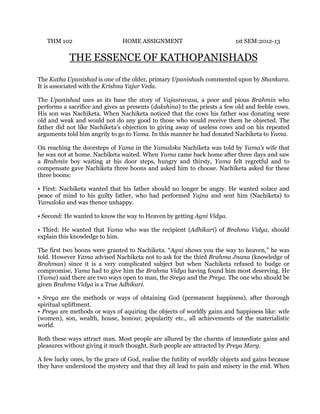
kathopanishads
- 1. THM 102 HOME ASSIGNMENT 1st SEM:2012-13 THE ESSENCE OF KATHOPANISHADS The Katha Upanishad is one of the older, primary Upanishads commented upon by Shankara. It is associated with the Krishna Yajur Veda. The Upanishad uses as its base the story of Vajasravasa, a poor and pious Brahmin who performs a sacrifice and gives as presents (dakshina) to the priests a few old and feeble cows. His son was Nachiketa. When Nachiketa noticed that the cows his father was donating were old and weak and would not do any good to those who would receive them he objected. The father did not like Nachiketa’s objection to giving away of useless cows and on his repeated arguments told him angrily to go to Yama. In this manner he had donated Nachiketa to Yama. On reaching the doorsteps of Yama in the Yamaloka Nachiketa was told by Yama’s wife that he was not at home. Nachiketa waited. When Yama came back home after three days and saw a Brahmin boy waiting at his door steps, hungry and thirsty, Yama felt regretful and to compensate gave Nachiketa three boons and asked him to choose. Nachiketa asked for these three boons: • First: Nachiketa wanted that his father should no longer be angry. He wanted solace and peace of mind to his guilty father, who had performed Yajna and sent him (Nachiketa) to Yamaloka and was thence unhappy. • Second: He wanted to know the way to Heaven by getting Agni Vidya. • Third: He wanted that Yama who was the recipient (Adhikari) of Brahma Vidya, should explain this knowledge to him. The first two boons were granted to Nachiketa. “Agni shows you the way to heaven,” he was told. However Yama advised Nachiketa not to ask for the third Brahma Jnana (knowledge of Brahman) since it is a very complicated subject but when Nachiketa refused to budge or compromise, Yama had to give him the Brahma Vidya having found him most deserving. He (Yama) said there are two ways open to man, the Sreya and the Preya. The one who should be given Brahma Vidya is a True Adhikari. • Sreya are the methods or ways of obtaining God (permanent happiness), after thorough spiritual upliftment. • Preya are methods or ways of aquiring the objects of worldly gains and happiness like: wife (women), son, wealth, house, honour, popularity etc., all achievements of the materialistic world. Both these ways attract man. Most people are allured by the charms of immediate gains and pleasures without giving it much thought. Such people are attracted by Preya Marg. A few lucky ones, by the grace of God, realise the futility of worldly objects and gains because they have understood the mystery and that they all lead to pain and misery in the end. When
- 2. these people follow the Sreya Marg (way) and pursue it diligently, all their sufferings come to an end and they become one with the infinite Ananda-Swaroopa of Paramatman. Some important Slokas of ‘Kathopanishad’ Contemplative minds, when faced with Sreya and Preya, try to analyse and understand them individually. Those endowed with refined and developed mental faculties pursue Sreya. But those who do not possess discerning ability and cannot apprehend the truth rush into Preya, attracted by their temporary glitter of success and fame. They believe in guarding their assets and striving for more; this is ‘Yoga Kshema’. Vidya and Avidya are two opposite methods to achieve what you want. Worldly pleasures, cannot lead to personal enlightenment and so one who travels on the path of personal welfare (Kalyana), rejects worldly pleasures considering them to be the cause of all sufferings. “O! Nachiketa, I believe that you are interested in this kind of Knowledge since great worldly gains could not entice you.” While explaining the nature (Swaroopa) of Brahman Yama tells Nachiketa that Om is the symbol of Absolute Brahman which cannot be destroyed and is also known as the ‘Parama Purusha’ – (Absolute or perfect man). Brahman and Para Brahman are known as the ‘Omkara’ or ‘Om’. The practitioner can attain any of the two Abhishta Rupas. This is the best way to acquire (reach) the Paramatman. Symbol "OM" ***********----------*********----------*************
